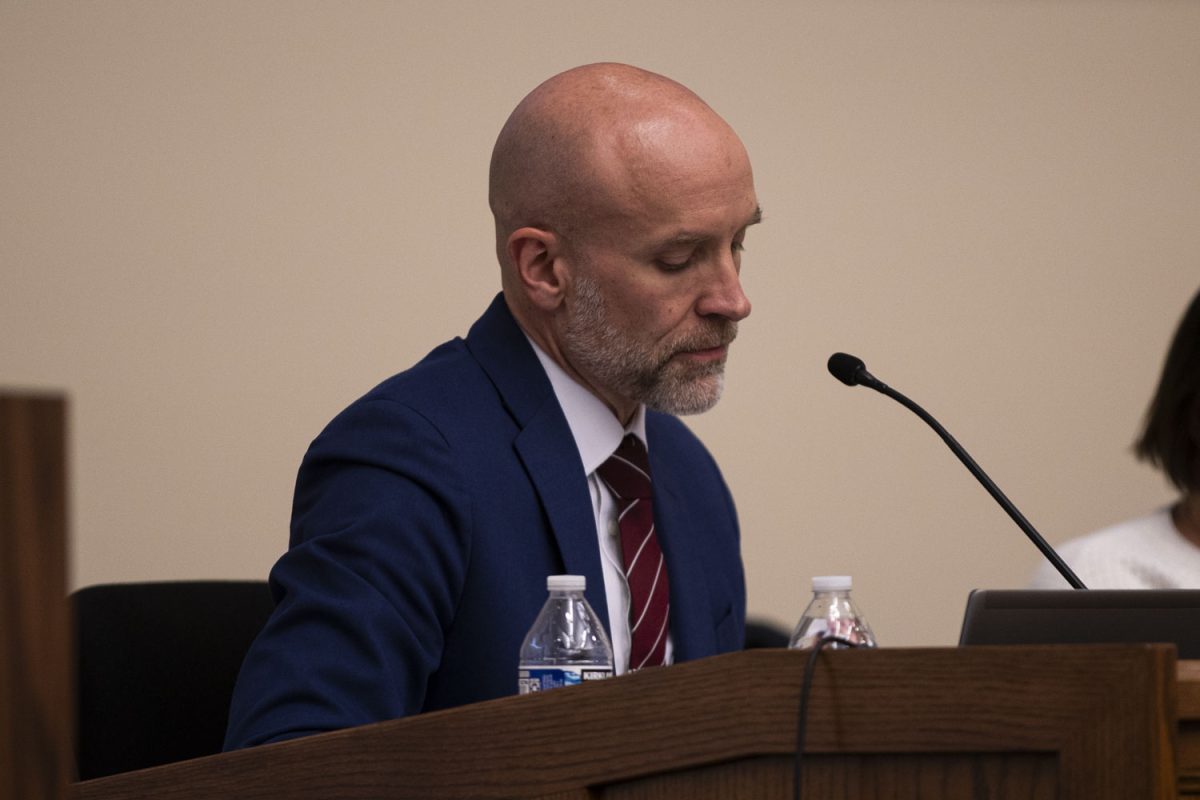
Larry Sailer, a farmer from Franklin County, is one of seven children who owns 10 percent of his family’s farm corporation. The 61-year-old also has his own livestock operation. While he is old enough to have grandchildren, he has no plan in place for the estate he will one day leave behind.
The seasoned farmer said there are two key reasons he has not yet created plans to pass down his farmland. First, his father is still alive and owns 30 percent of the family farm. He is waiting until the land is completely passed down to his generation.
Second, his children chose careers outside of agriculture, and he is waiting to see if one of his grandchildren wants to take over.
Stories similar to Sailer’s abound in Iowa. Owners of nearly 80 percent of Iowa’s farmland are 55 or older, according to the Iowa Farmland Ownership and Tenure report of 2012. In a couple of decades, a substantial transition of land ownership will shape the future landscape of Iowa agriculture.
This upcoming and widespread transition has created one of the biggest issues in agriculture today — the need for succession planning. This means the need to look ahead and plan for how and when farmland will be transitioned to the next in line.
Eight in 10 owners plan to pass their land to their families. This leaves two major unanswered questions: How will owners plan to transition and what will heirs do with the land they receive?
Three distinct possibilities for Iowa agriculture’s future emerged from a Daily Iowan investigation that included interviewing landowners and agriculture experts as well as reviewing related studies.
• A renewed interest in farming in which children succeed their parents, and agriculture continues as it has for generations, a transition some may call the ideal scenario.
The challenge of succession
More than half of Iowa’s farmland is owned by someone who has reached the age of retirement. This means by the time a college student is 45, more than 55 percent of farmland owners will likely have passed on their estates.
Landowners can address succession planning in two ways, said Ryan Drollette, a farm-management specialist with the Iowa State University Extension Office in Johnson County. One is to create a transition plan that takes place while the landowner is still alive. These plans can take many forms but usually result in the owner gradually transitioning control to a successor.
The second path an owner may choose is to will the land to a successor after death.
The trickiest aspect of either transition plan is the taxes owners incur. Some farmland in Iowa is worth $10,000 an acre, according to the 2013 Iowa Land Value Survey. This means if an owner has 550 acres, he may possess $5.5 million in assets. At the federal level, a gift is taxed at 35 percent after $5.34 million.
The remaining $160,000 would be taxed if all of the land was gifted at one time. Owners typically couldn’t pay those taxes and would have to sell land. Drollette said owners don’t want to lose the land they struggled to hold onto through the farm crisis of the 1980s.
Sailer is one such owner who managed to survive a time when agriculture was brought to its knees. The crisis was caused by a combination of factors, including drought, poor prices, debt, and a federal block on exports to, at that time, the Soviet Union.
“The very biggest challenge was that interest rates skyrocketed,” Sailer said. “Back then, you couldn’t handle very much debt at all because interest just ate you alive.”
Sailer, like many other landowners, said that after the ’80s, he wanted to make sure he maintained the land he had.
Therefore, farmers often look for ways to circumvent taxes that could result in a loss of land. Selling and willing land to successors also produces a tax liability that would result in a land division. Land has appreciated over the years, so in selling it, owners face capital-gains taxes. When willing land after death, heirs face estate taxes.
One option for avoiding taxes is giving up to $14,000 worth of land to an heir each year, but at today’s prices, this might only amount to 1.4 acres a year.
Families also put land into corporations and trusts to avoid taxes. They can transfer assets through these entities without incurring capital-gains or estate taxes.
Because of the complexity of succession planning, the Iowa Farm Bureau recently created a program called Take Root, to help families choose a succession plan that works best for them.
For families who do break through what can be a confusing process, it is still unclear what the majority of younger people will do with the land their parents leave behind.
Drollette said it is very difficult to measure the interest of young people in agriculture objectively, and the state is going to have to wait to see how the future of Iowa agriculture unfolds.
The ideal scenario
This was the case for many families in the years following the farm crisis.
After surviving the 1980s, Sailer said, he and his wife encouraged their children to pursue jobs outside of agriculture so they wouldn’t have to undergo the level of hardship they had faced. As he holds off on his succession plan to see what his grandchildren will do, there are still elements of skepticism in the family about the stability of farming.
“Grandma kind of thinks they should all go and find better jobs,” he said, referring to his wife.
Scott Johnson, Iowa FFA Association executive secretary, said this was a trend following the 1980s.
Similarly, enrollment at Iowa State Universities in the agriculture-studies major — the most common major of students who plan to return to the farm — has seen an increase.
In 1980, before the crisis hit, enrollment in the farm-operation major (now called agriculture studies) was more than 400 students. Ten years later, enrollment had fallen to 161 students. Today, enrollment in ag studies is nearly 350.
Aaron and Laura Cunningham, both 25, recently graduated from ISU and are part of the younger generation that wants to get back on the family farm.
Aaron Cunningham’s family farm is currently owned by his father Grant, 60. They own more than 1,000 acres. Because of tax concerns, Laura Cunningham said the family has decided that creating a family-farm corporation is the best route for them.
Aaron and Laura Cunningham own their own cattle operation and are waiting for the transition process to begin so they can play a larger role in the crop production side of the family business.
“My husband’s dad is ready to start scaling back, but he wants to do it in a way that [Aaron Cunningham and his younger brother] learn what they need to learn and are able to ask questions,” Laura Cunningham said.
Johnson said that in recent years, there has been a push toward the idea there are many opportunities for young people in agriculture outside of farming. People are needed in research, business, and even in more unexpected careers such as public relations.
So while enrollment in ISU’s College of Agriculture and Life Sciences has gone up by more than 1,000 since 2000, this doesn’t mean they all want to become farmers.
What does this mean for farmers such as Sailer who are looking for an heir for their legacy? Well, the answer is twofold.
First, the ideal scenario for family farms may be unrealistic. While more young people are interested in agriculture than they were 20 years ago, it is hard to know how many of them actually want to farm.
Second, fewer farmers are needed in Iowa agriculture today than in the 20th century because of the advancement of technology. Farmers can now plant and harvest more and more ground in the same amount of time. This naturally lends itself to farms increasing in size and consolidating.
So, if fewer young people want to go into the field, it may not be a big problem.
The nightmare scenario
As much as family farmers know what they want to see for the future of agriculture in Iowa, they also know what they don’t want to see — large corporations monopolizing the industry.
“You’re not going to mitigate the fact that farms will continue to get larger,” said Craig Hill, the president of the Iowa Farm Bureau. “But what you want to see … is a family, and their capital, and their knowledge and management, and their own labor going into that farm. You want to see it all combine in what we call a family farm.”
The concern is if large or non-family corporations become more prominent, the profit made off that land wouldn’t be reinvested in the local economy.
Laura Cunningham said that a few years ago in their town outside of Mason City, there was a plot of land that went up for sale and was purchased by someone who lived in another part of the state. When something such as this happens — even if the owner isn’t a corporation but perhaps a wealthy landowner — the owner invests profits from the land in her or his hometown and likely buys equipment for the farm there.
Laura Cunningham said this is a slow growing trend farmers need to be aware of. Selling land used to be more of a neighbor-to-neighbor transaction, but now there are buyers from around the state who go to auctions and tend to have deeper pockets, she said.
Because not every family farm has an heir interested in taking over, it is likely more land will be sold in the coming years. But there is concern the remaining family operations won’t be able to compete with large corporations [defined in Iowa law as corporations with more than 25 shareholders] or wealthy out-of-town owners.
To protect family farms from being overrun by large corporations, laws exist in Iowa to prevent land or livestock operations from being owned by large and non-ag corporations.
There are, however, ways large corporations can play a role in Iowa agriculture. For example, the law has no restriction on how large a farm corporation can be as long as all shareholders are related. Roger McEowen, the director of the ISU Center for Agriculture Law and Taxation, said this can result in multimillion-dollar corporations from around the country owning land and livestock in Iowa.
He also said that in the last decade, conditions have become somewhat easier for corporations to buy land, in part because the Iowa Attorney General’s Office no longer has a farm division to seek out and enforce the law on violators.
It is still a risk for an unauthorized corporation to buy land in Iowa, but the enforcement would only take place if the Attorney General’s Office was made aware of the violation.
“We don’t have the resource to go to every county courthouse and look to see if corporations are buying Iowa land,” said Eric Tabor, the chief deputy in the Attorney General’s Office.
The hybrid scenario
There appears to be a consensus among those involved in agriculture that while it is unclear what the future holds for farming in Iowa, it is unlikely either the ideal or the nightmare scenario will completely come to fruition.
Instead, experts suggest, it is likely the landscape of agriculture in Iowa will be more heterogeneous and involve both family farms and corporations coexisting along with other forms of ownership arrangements.
A growing trend is renting. Landowners who don’t have family to succeed them can rent land to younger people and benefit from the rental fee.
Renting land can potentially have a mixed economic impact. It may hurt small-town economies in a similar way as large corporate operations, because the owners may not live in Iowa or contribute to the state economy, said Neil Hamilton, a Drake University law professor. This is called absentee farming.
However the farmers who work the land are likely to live near the local town and support local schools and businesses. John Baker of the ISU Beginning Farmer Center said they also usually own the crops they produce and will have the profits to reinvest in the community, as opposed to a corporation owning the profits and sharing them with their stockholders.
In 1982, slightly more than 20 percent of land was rented in Iowa. As of 2012, 46 percent of land was rented. There has also been a 14 percent increase in the number of landowners who are not full-time Iowa residents.
Another practice becoming more common that contributes to the hybrid scenario is contracts between Iowa growers and corporations.
There are laws in Iowa to protect against vertical integration in agriculture — for example, a packing corporation owns hogs through the entire production to packing process and hires a farmer to raise them, as opposed to the farmer owning the hogs and then selling them to a packing plant.
But in 2005, a case concerning Smithfield Foods, one of the largest pork processors in the country, resulted in the state effectively ceasing to enforce the law.
McEowen said Smithfield claimed the law was unconstitutional because it illegally impeded commerce, and the attorney general didn’t think the state would be able to win a court battle because other state courts had struck down similar laws.
The case was settled outside of court. Smithfield agreed to create contracts with farmers that guaranteed rights and fair treatment, and in return, the state would not enforce the law. This agreement will expire next September.
“The idea is to extend those agreements for a period of time,” Tabor said. “Everyone thinks that’s working pretty well, and if we had to go back to argue the constitutionality of the [law], we think that would be a pretty big uphill battle.”
Baker said he expects corporations are going to be less concerned with buying up land and livestock operations in the future and more interested in furthering vertical integration.
While many possibilities exist, no one can say with certainty what the future holds.
Sailer sums it up perfectly when he talks about waiting for an heir to potentially emerge among his grandchildren.
“I’m basically sitting tight, and we’ll see what happens,” he said.






